Tropical garden ideas: 16 ways to transform your backyard into an exotic oasis
These tropical garden ideas will give your plot an instant holiday vibe – from colorful planting picks to jungle-themed features and more
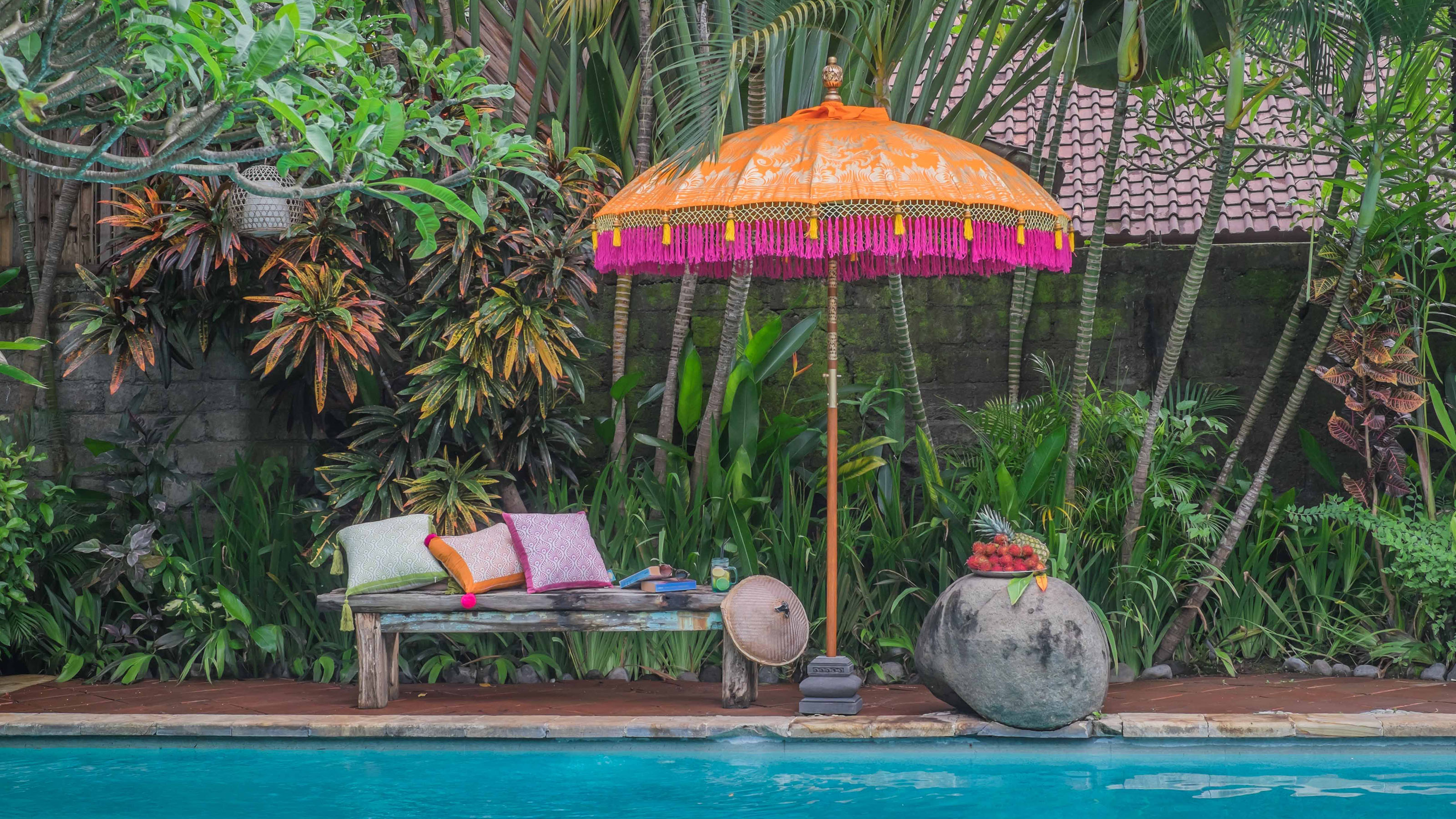
Exotic-style plots equal color, drama, and atmosphere, and these tropical garden ideas offer exactly that. They're ideal if you want to transform your backyard into an escape reminiscent of faraway holiday destinations. And who doesn't want a personal slice of paradise right on their very own doorstep?
Although the look hails from warmer climes, it's easy to adapt it to all manner of gardens for a sense of tropical-chic whatever the weather. Plenty of vivid tones, lush greenery and funky features perfect for outdoor entertaining will instantly warm up a plot, even if the skies above are grey.
You don’t need oodles of space either – this style is a great solution for smaller, urban garden design ideas as well as larger backyards. By using architectural foliage, you can create sheltered private spaces and screen out bulky buildings. Plus, the higher temperatures in cities are often beneficial for growing tropical plants.
Tropical garden ideas: 16 top looks for holiday-style plots
Whatever type of backyard you have, there are many ways to get the tropical look, from lush-looking plants that are surprisingly hardy to beautifully vibrant furniture. We've rounded up some of favorite tropical garden ideas below for you to peruse.
1. Pair bright colors with a living wall
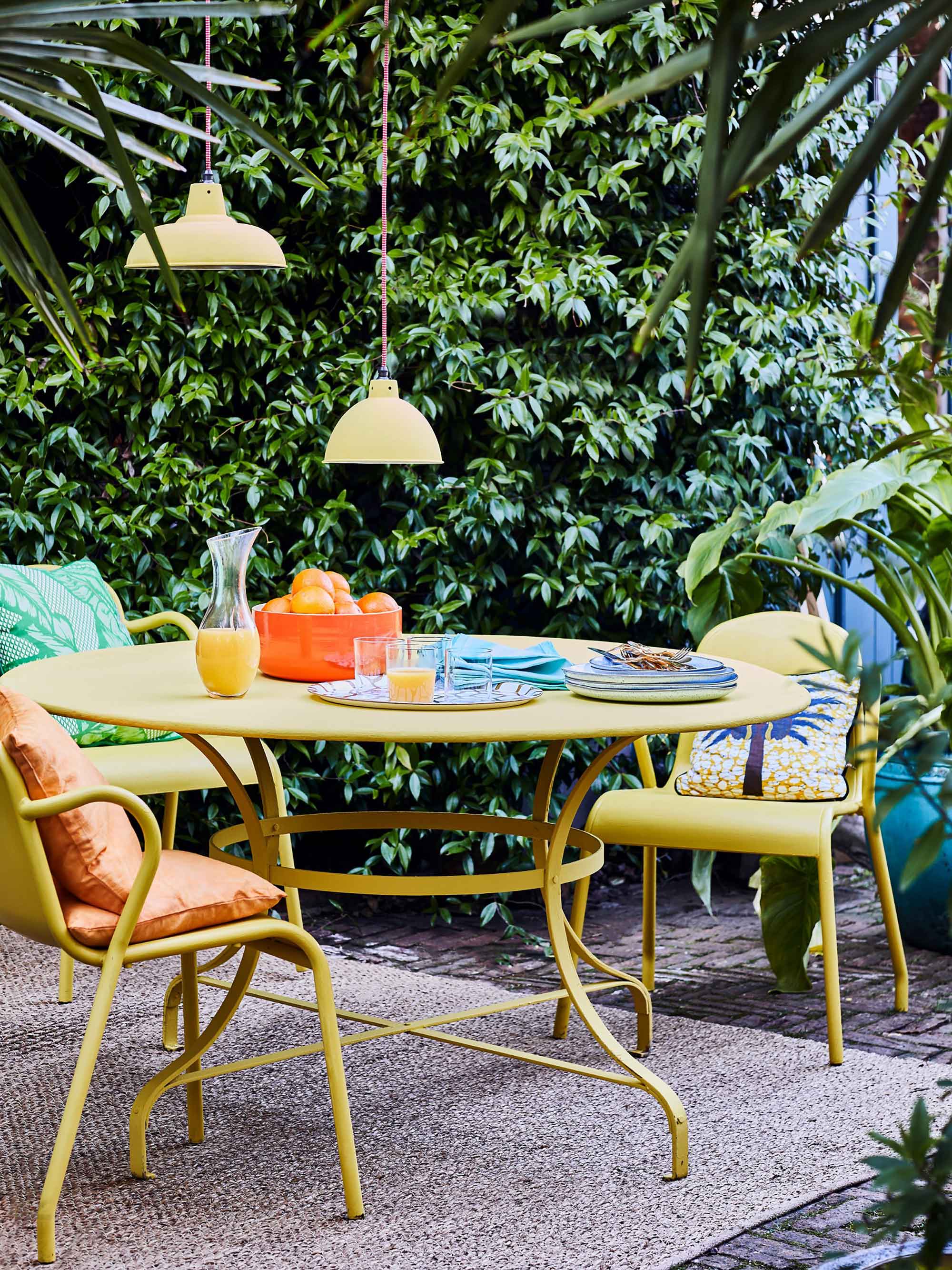
This dining set painted in Annie Sloan English Yellow chalk paint makes a stunning feature against a leafy backdrop
A simple way to liven up a lacklustre plot is to give your neutral-toned furniture a bolder hue with exterior paint. It's a great way to spend a sunny afternoon, and is much more affordable than splashing out on a whole new set-up.
As demonstrated here, bright yellow tones instantly add a boost of tropical vibrancy to a space, especially when surrounded by lots of leafy foliage. A hedge can do the job well, but a living wall can be a faster solution – plus you can plant it up with a mix of varieties for a real jungle-like feel.
Accent the scene with more pops of color – these cushions are the perfect complement for a summery feel. Don't forget to add lighting to the mix too, so you can enjoy the vacation vibes well into the evening. Pendants like these add a modern twist, but opt for antique-effect lanterns for more of an old-world vibe.
2. Create a tropical-inspired spot for outdoor bathing
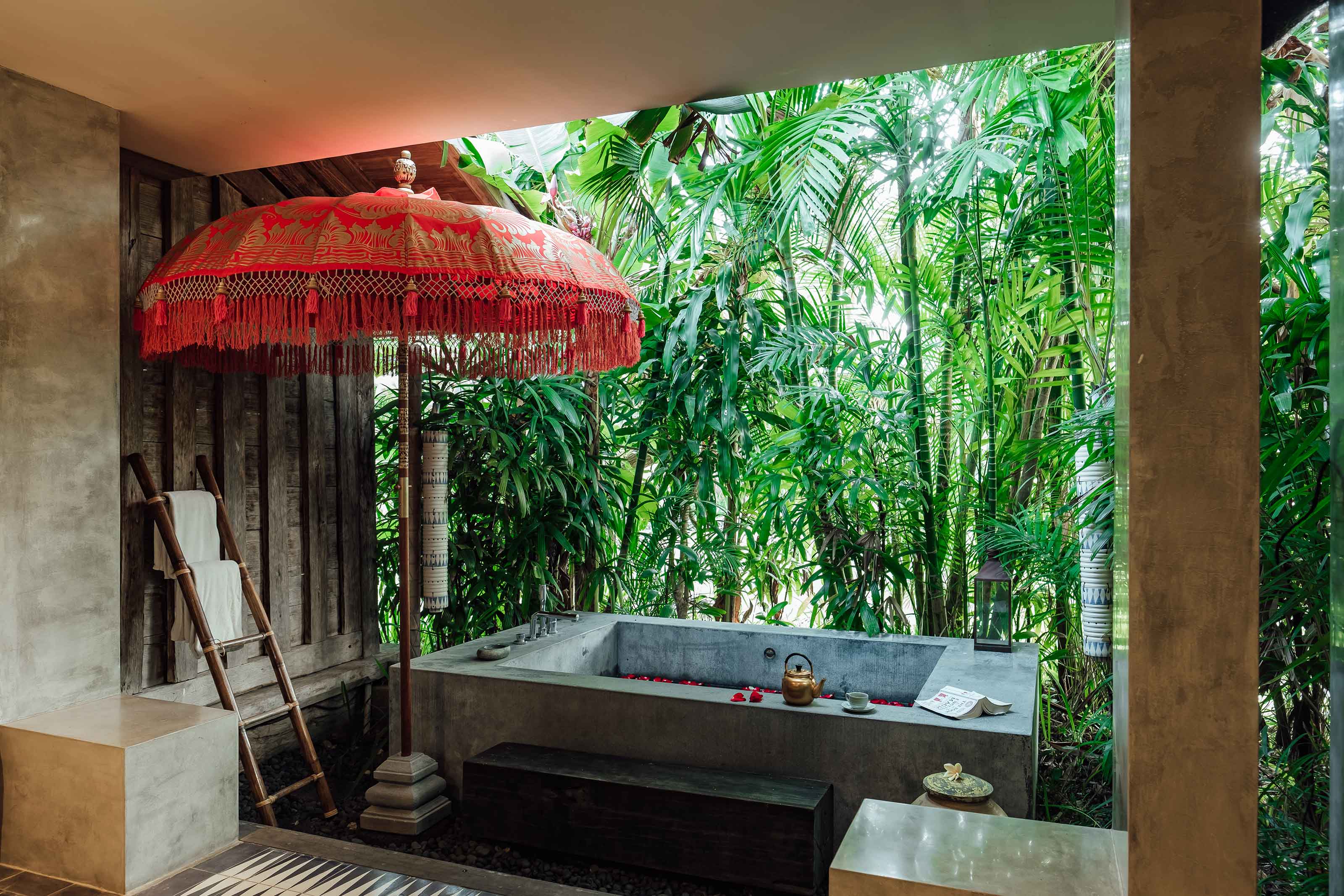
The Olivia parasol from East London Parasol Company looks lovely beside this small tropical-style tub
If you can't find the room for a full-sized swimming pool, plunge pools or hot tub ideas make fantastic alternatives. They're great for enhancing that holiday-hotel ambience and bringing a touch of luxury to your plot.
By using a screen of green to boost the privacy levels, you'll feel like you're in your own private rainforest. Bamboo is a fitting choice and grows quickly. Keep the design of the tub itself simple and sleek for a contemporary finish – it will help to balance out all the textural foliage that surrounds it.
3. Spruce up a smaller space with potted palms
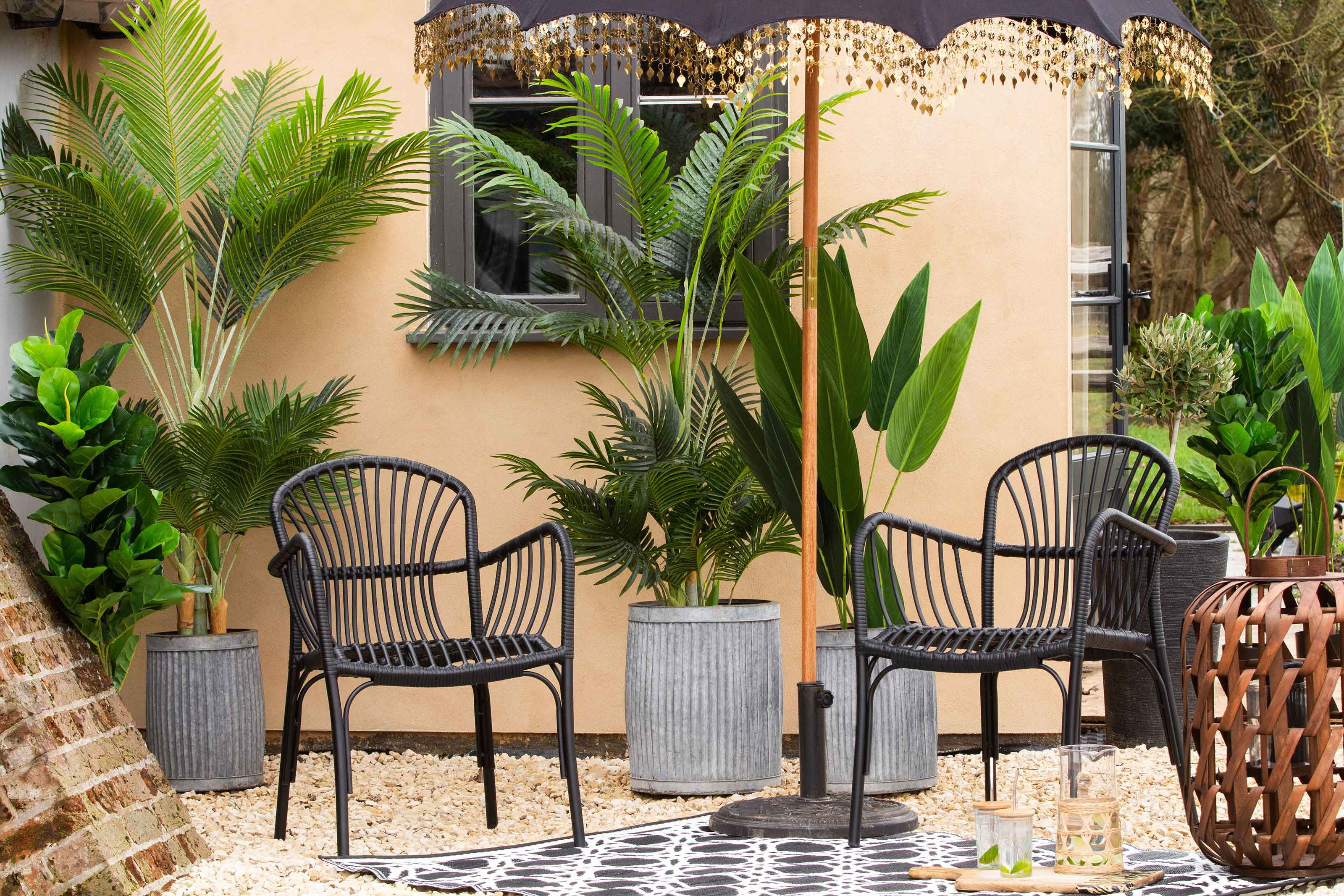
A small yet totally tropical set-up from Rockett St George
Even if you've only got a small courtyard, patio, or balcony to play with, you can still embrace tropical garden ideas. Plenty of large containers placed close together can recreate the sense of a tropical border – especially if you fill them with palms.
There are plenty that will thrive happily as container gardening ideas – try the European fan palm, the pygmy date palm, or the silver saw palmetto, for instance. What's more, these types are forgiving to bouts of cooler temperatures (although it is best to protect them from frost).
Try bringing the architectural Fatsia japonica into the mix too – its large, leathery leaves and resilient nature make it a reliable and attractive addition.
4. Or, go big and bold for a real sense of luxury
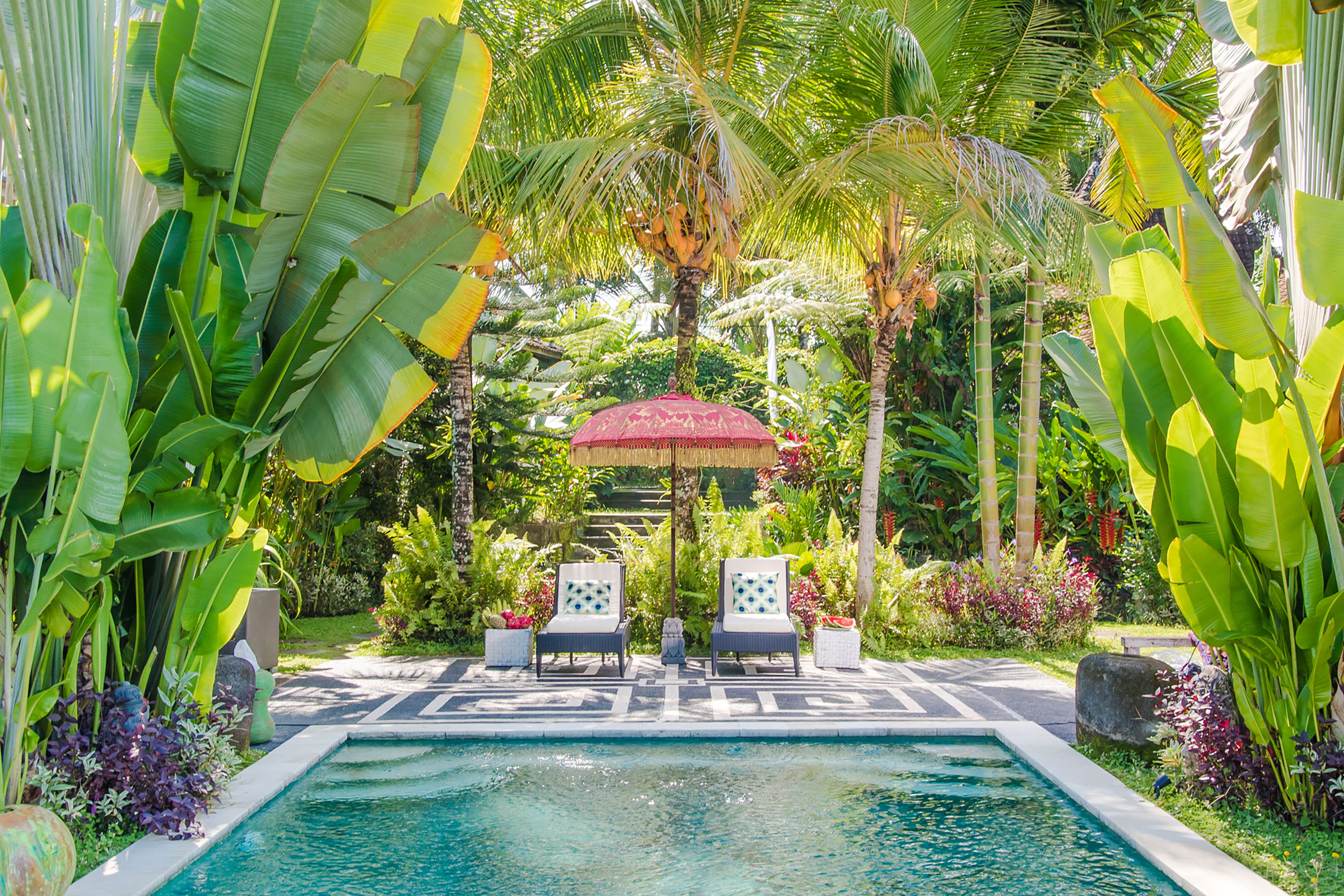
The Whitney parasol from East London Parasol Company makes a colorful addition to this beautiful pool
Backyard pool ideas and tropical garden ideas are a perfect combination for serious vacation vibes. So, if you've got the budget and are ready to go all out, then perhaps this stunning set-up will inspire.
By using tall leafy plants around the perimeter of the pool, you'll feel as if you're taking a dip in the middle of a jungle. Opt for bold, patterned paving for an extra touch of elegance, and don't forget a couple of sun loungers for relaxing on post-swim.
5. Serve up tropical cocktails from a rattan bar
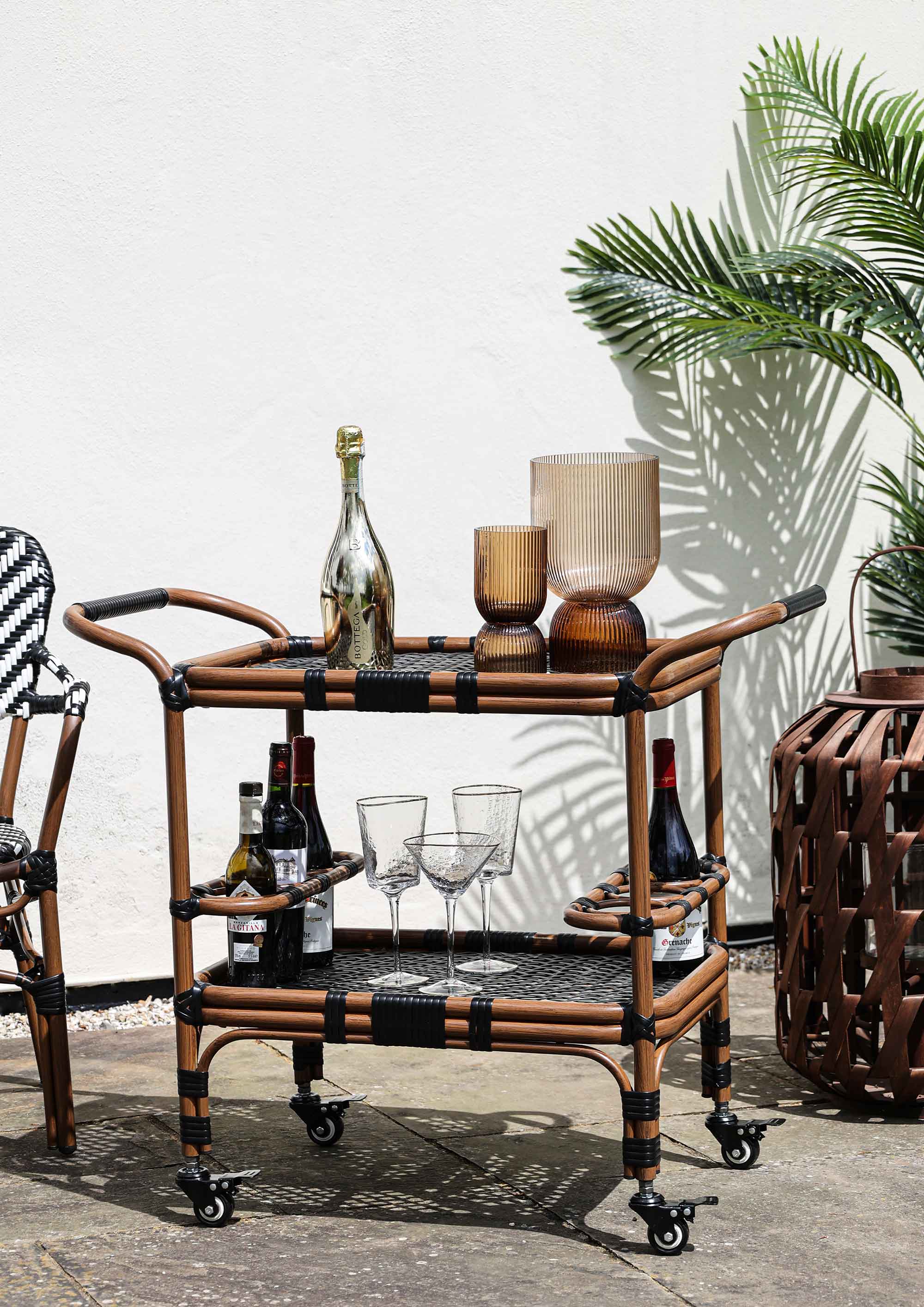
This rattan bar trolley from Rockett St George is a stylish choice for serving up island-inspired cocktails
Whether you prefer a Mai Tai, a Piña Colada or a Tequila Sunrise, an island-style cocktail or two is an ideal addition to tropical garden ideas. And, if you're a fan of outdoor entertaining, your guests will probably agree.
So, to liven up those alfresco evenings spent in your own backyard oasis, consider investing in outdoor bar ideas. As Rachel Fell, Furniture Buying Manager of Habitat says, they add 'a new dimension to outdoor spaces, making way for the growing home-mixology trend.'
A nifty design like this is a good choice for versatility and looks the part, too.
6. Add a splash of color with a vibrant parasol
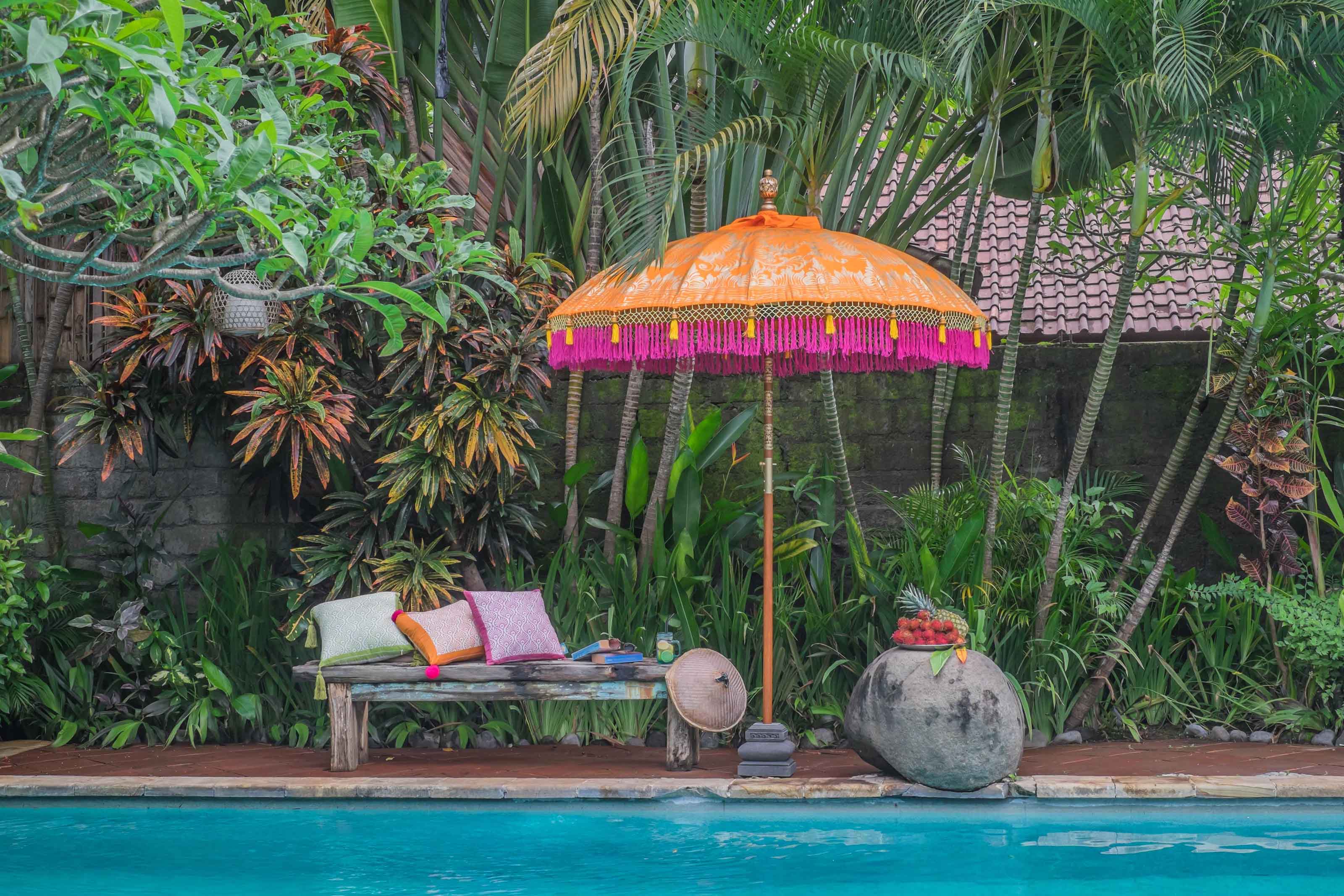
The Etta parasol from East London Parasol Company simply dazzles in this tropical haven
For the warmer months, it's always good to be prepared with one of the best garden parasols. They're an easy and attractive way to provide shade and shelter without taking up much floor space.
If you're opting for tropical garden ideas, embrace the opportunity to pick a design which extends the theme. Take this sumptuous orange and pink style, for example. It's makes a real statement alongside a shimmering azure pool, but would look just as lovely on a patio, too.
7. Get inspired by your favorite vacations
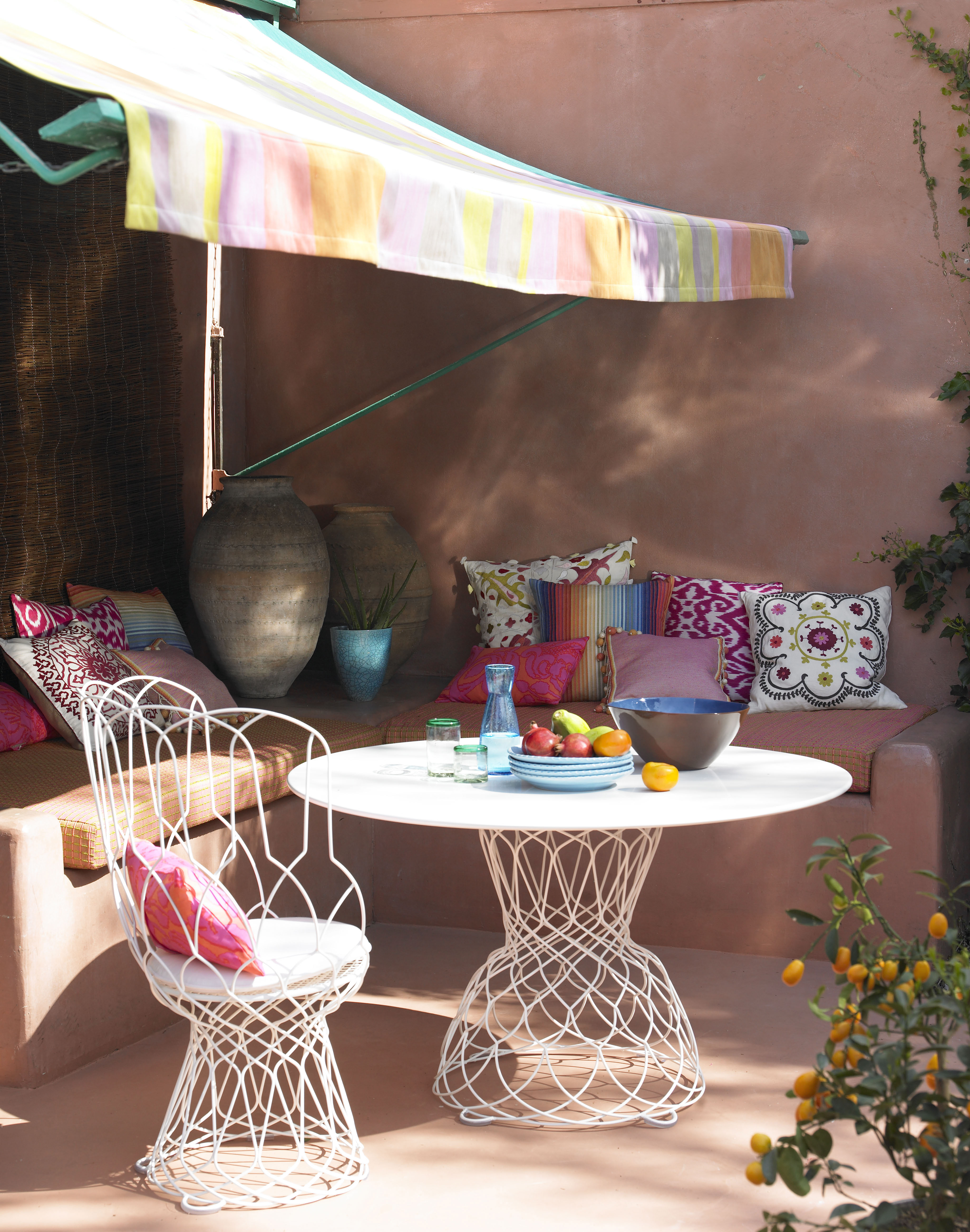
A pretty pastel awning evokes the feeling of a summer getaway and will help to keep you cool
For exotic inspo, look online at your favorite destinations, or get ideas from holiday photos. You don’t have to start from scratch – you can transform your existing garden by taking up the lawn, putting in a path, and planting around that.
Include patio ideas or decking so you've got a secluded place to sit. Be sure to add a pretty shade sail or awning ideas too – this stripy number is full of tropical charm.
8. Make a statement with architectural forms
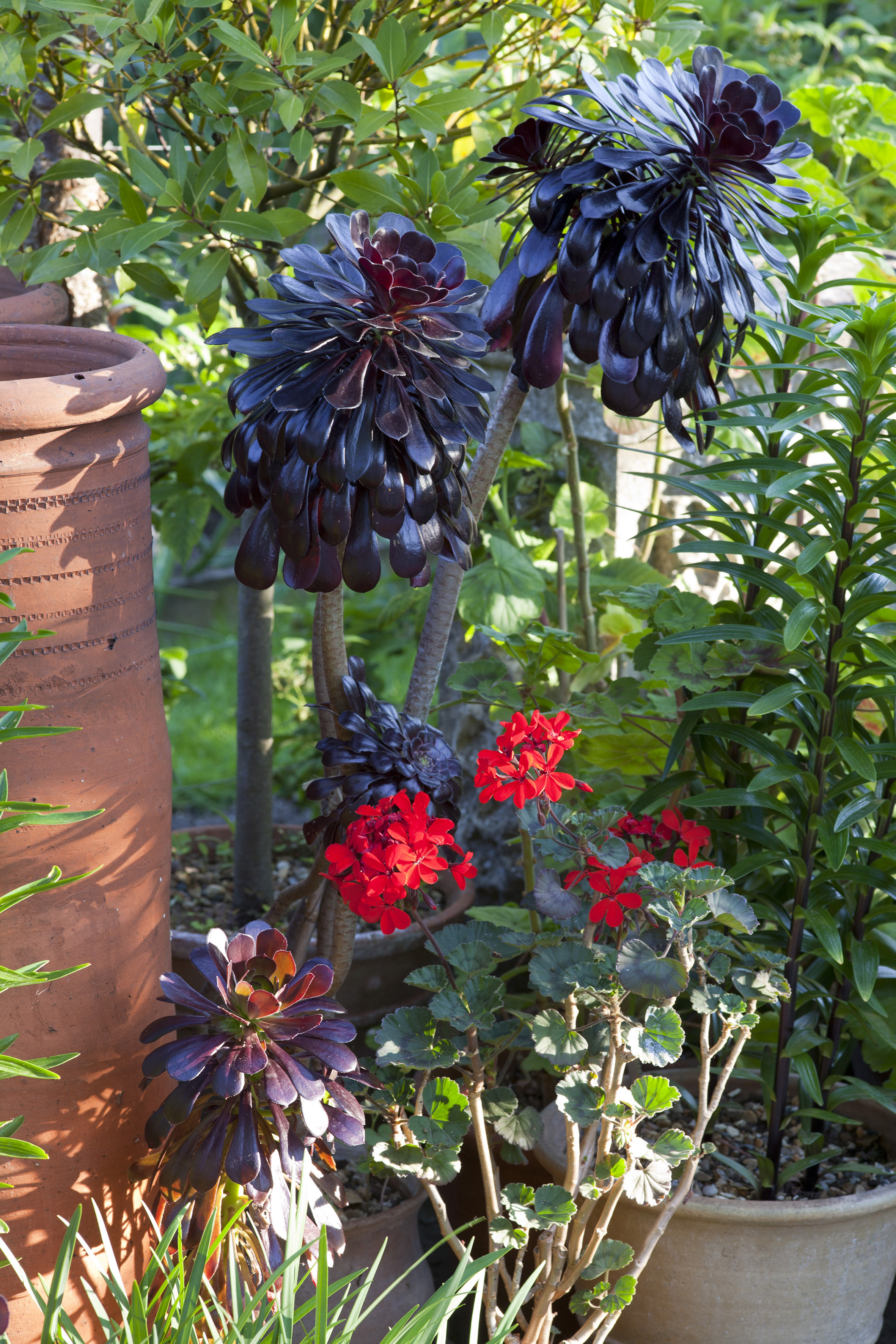
Go for striking shapes when choosing plants for your tropical garden ideas
Look at form and foliage – exotic style is about impactful, contrasting evergreens. Texture is important too – contrast the glossy green leaves with more delicate, lacy ones.
Plant dense undergrowth with low-maintenance grasses and evergreen ferns in large clumps, repeating them round the garden. Polystichum setiferum (soft shield fern) has a ‘Jurassic’ presence, with its huge evergreen leaves.
9. Inject some color with bold florals
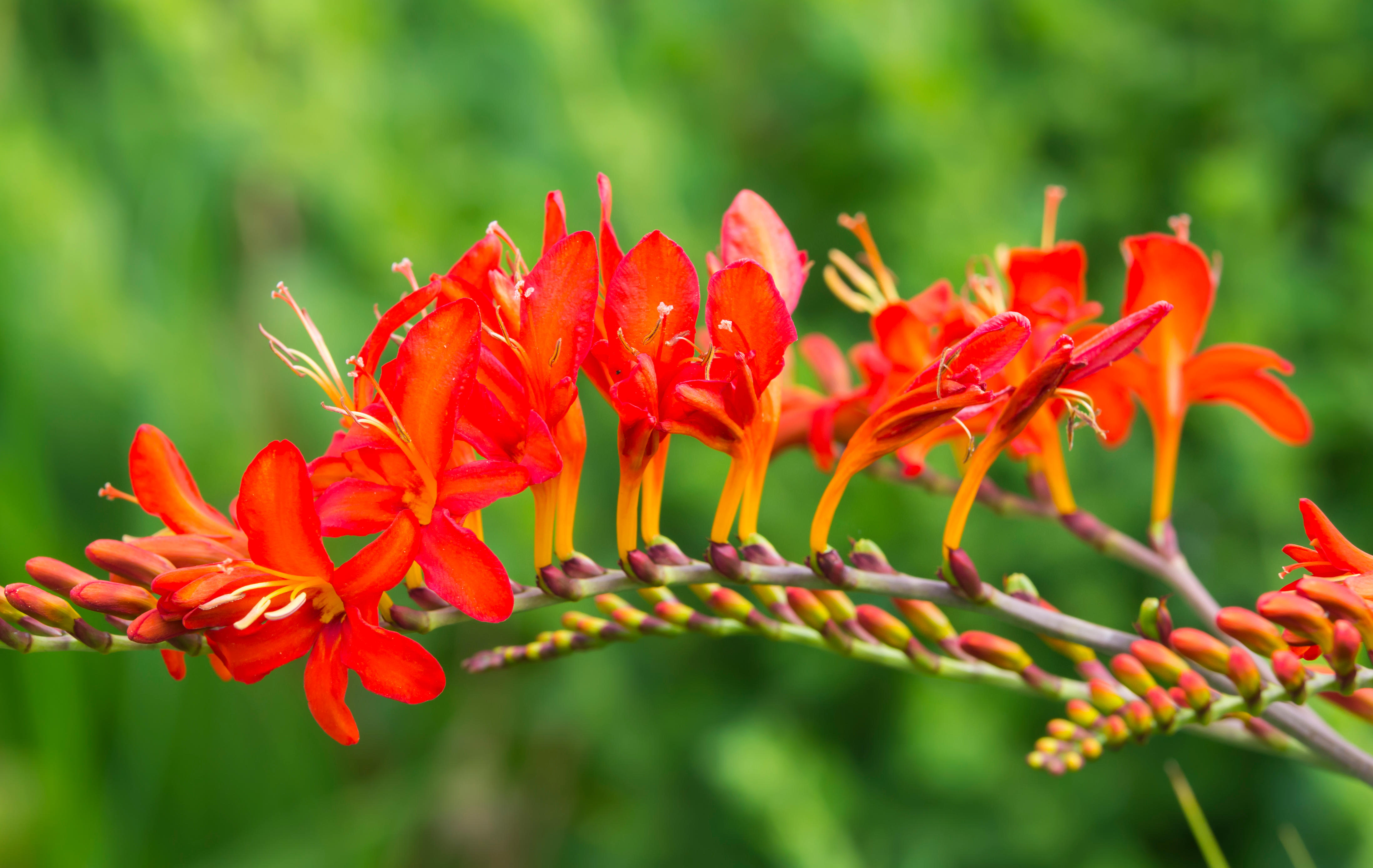
Flame-hued crocosmia has a tropical feel
For color, go for a few bold hits from tender exotics like cannas dotted around in summer, peeping through the green background.
Most exotic and tropical plants are pretty easy to care for so will work for low maintenance garden ideas. You'll need to water them while they establish and tidy them now and then, but they're certainly far less work than herbaceous borders or lawns.
10. Brighten up shady spots
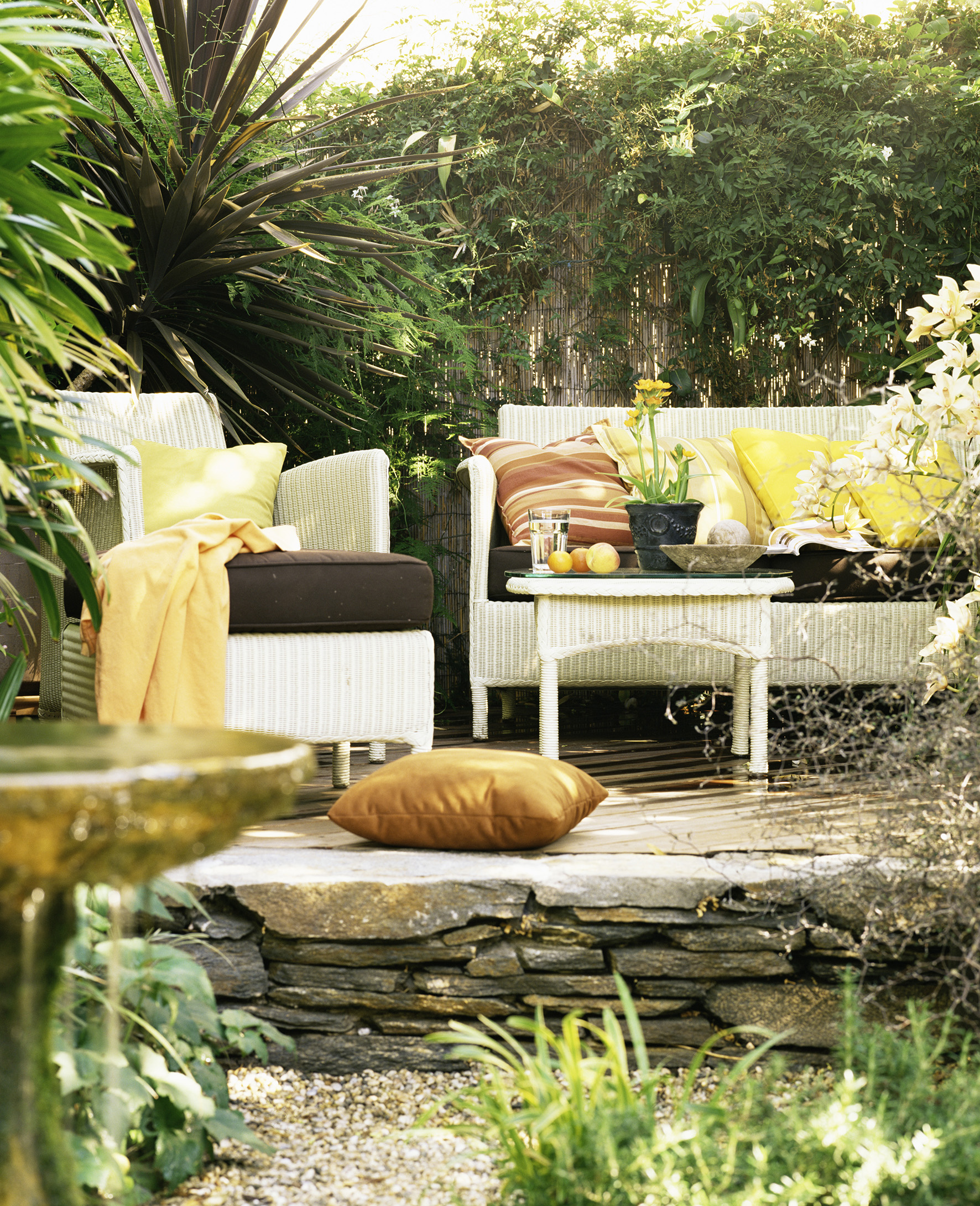
Warm tones pep up this space
Shady garden? No problem – shade is no bar to the exotic look. In fact, shade-loving plants like dicksonia and hostas positively thrive in shade, and will provide exactly the jungle-like ambience you're after. Bamboos, too.
Trachycarpus (the windmill palm), cordyline (Torbay palm) and Musa basjoo (banana) also tolerate partial shade. Most ferns are happy in shade too, as are many grasses. Take hakonechloa for example, a Japanese grass with bright green arching leaves and rusty winter color. Liriope is a grass-like evergreen perennial which loves shade, with added interest from purple flowers in September.
Bring additional color into the space with hot-hued accessories and your tropical garden ideas will be looking glorious in no time.
11. Pot up bright citrus trees
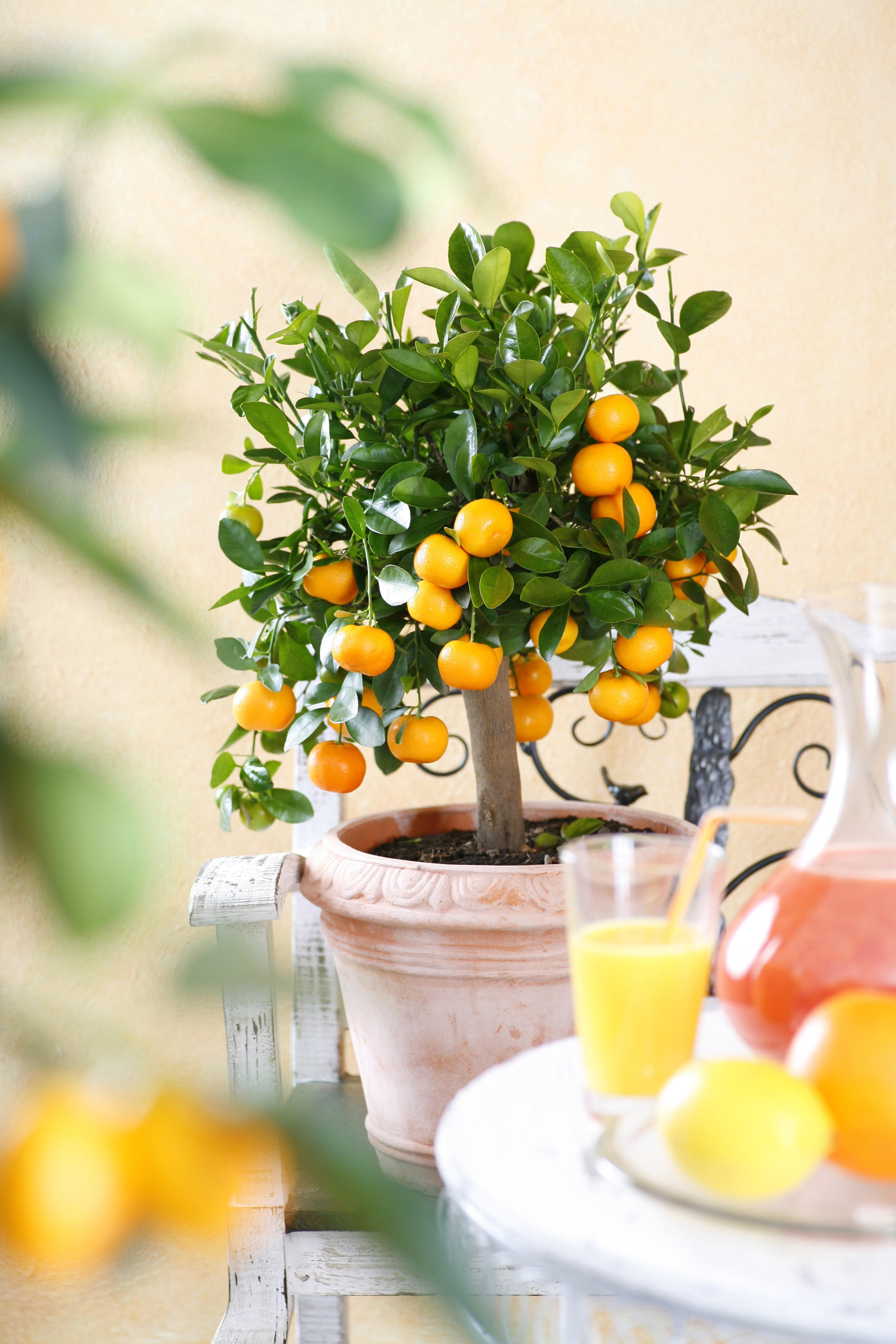
Bring a summertime touch to your small paved space with the help of potted citrus trees
Containers are ideal for tender plants like citrus trees that live outside in summer, and come back indoors for winter. This means you can go for exotic style even if you only have a patio.
Make a feature of your container displays in summer, grouping your pots prominently on the patio or deck. Remember to bring them inside before the first frosts in late autumn though – they make lovely additions to a conservatory but greenhouse ideas can come in handy too.
12. Add houseplants to the mix
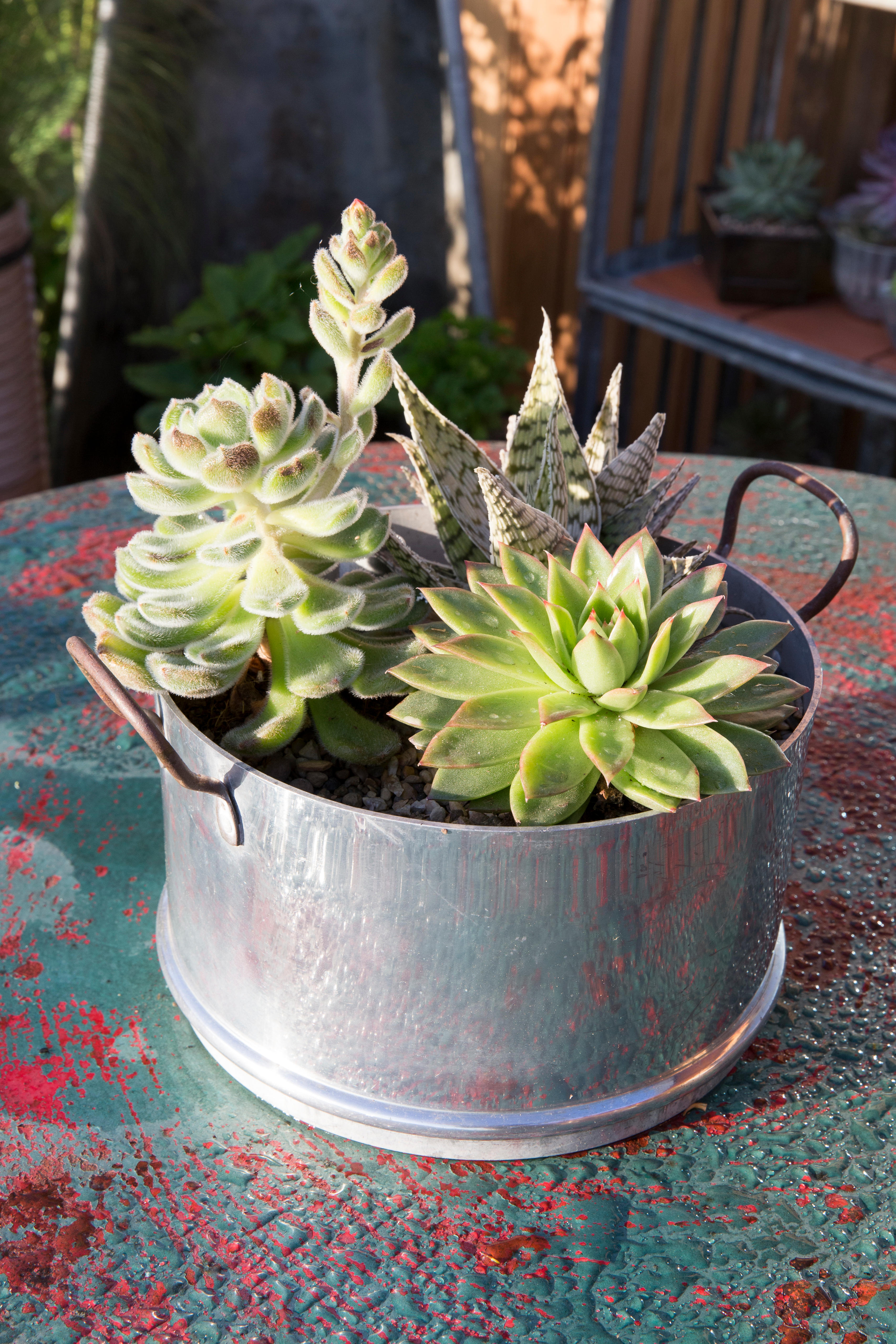
Succulents offer interesting forms and are easy to look after
Most houseplants enjoy a summer holiday on the patio, with warmer night-time temperatures. They'll benefit from the fresh air and extra light and will look healthier after their mini-break.
Cacti and succulents are fine in hot spots, and are best fed with specialist cactus feed. But, other plants need placing out of full sun, which can scorch their leaves. And some, like aspidistra, prefer full shade.
Display your houseplants together in groups and enjoy them up close outdoors. Water and feed as normal, and remember to bring them inside when night temperatures start dropping.
Need more advice? Our guides on cactus garden ideas and how to grow succulents have lots of useful tips.
13. Choose plants for drama
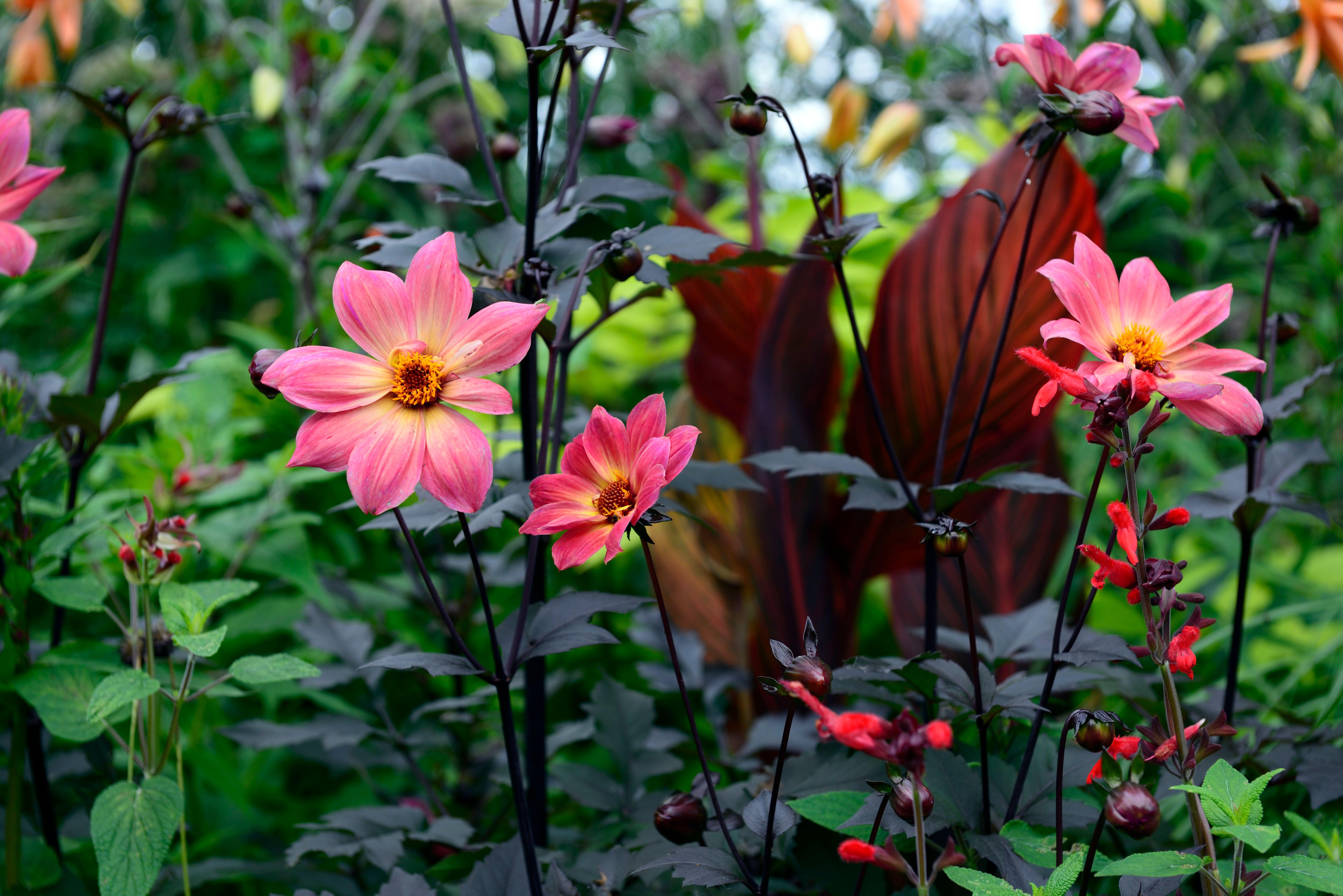
These richly toned dahlias and cannas make a stunning duo
Give your patio a tropical island look with a spectacular canna. The leaves alone are large, colorful and impressive. But, they are matched by equally dramatic blooms, which come in a bold selection featuring pink, red, yellow or orange.
They'll flower from June to September and reach heights of over a meter. Pair them in a bed with dahlias for a show-stopping display – our guide on how to grow dahlias is full of useful tips should you need them.
14. Go for bold materials for your tropical garden ideas
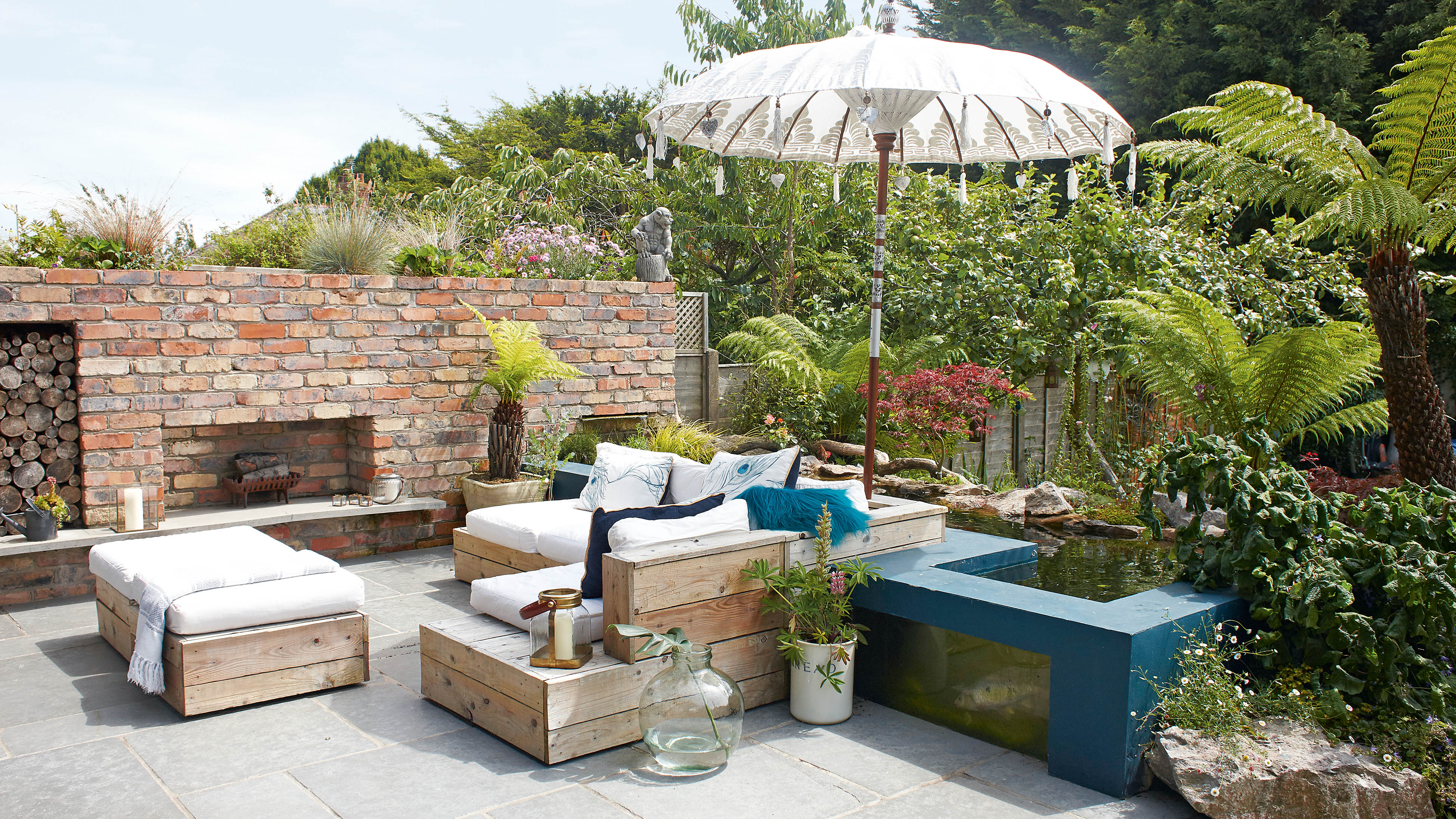
A mix of stone, paving and timber work well in this rustic-yet-tropical style plot
Tropical gardens are mostly about the plants and creating a jungle atmosphere. For structures, use bold materials to match the planting style. Think rough timbers for decking or pergolas, slate or bark chippings for paths, and bamboo for garden fence ideas.
In city gardens, paint fences with black or dark grey exterior wood paint so the greens of your planting really pop.
15. Put in a water feature
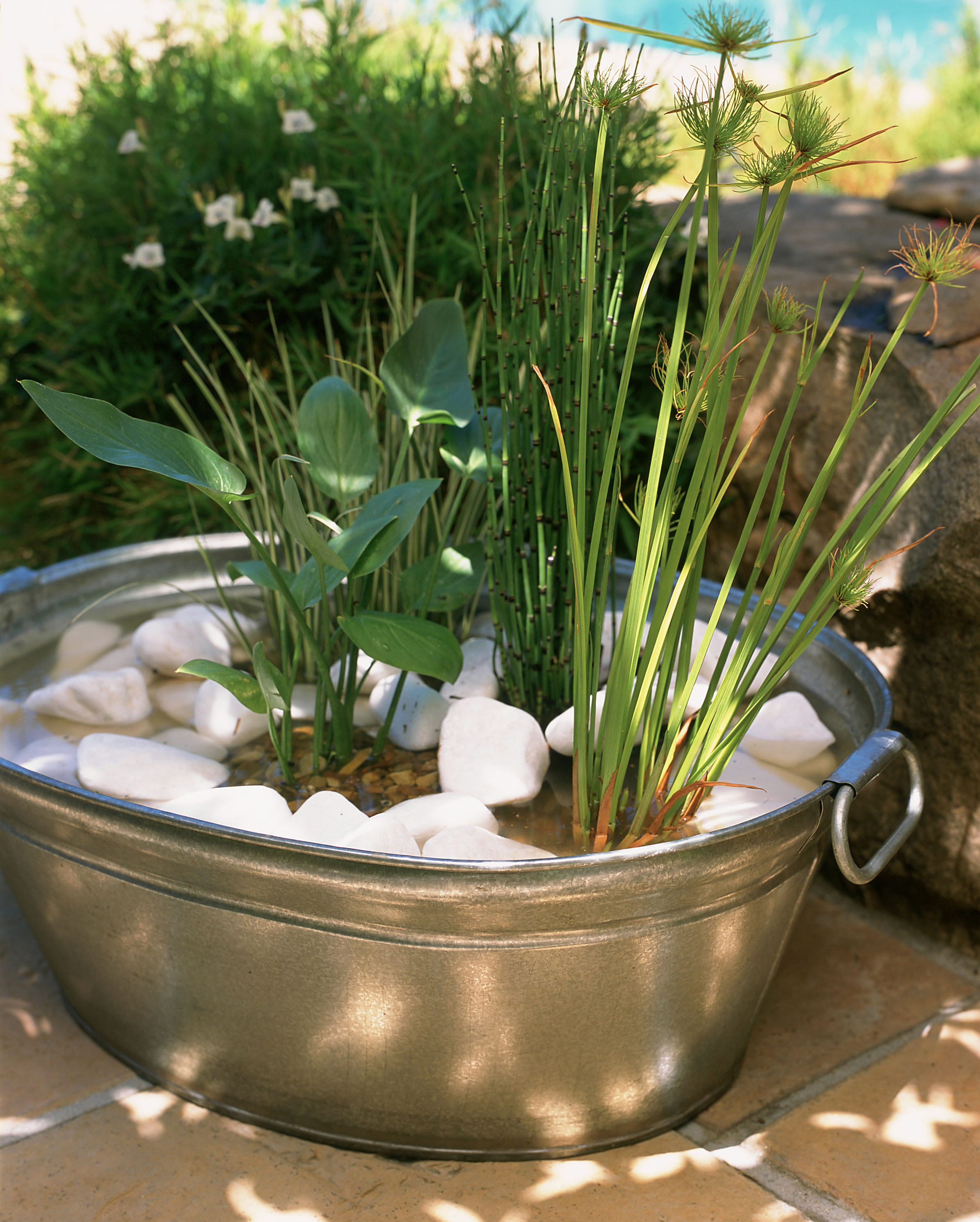
Even a small water feature can make a striking impression
A waterfall is great if you’ve got a big garden, but don't go chasing them if you don't have the space. There are plenty of water feature ideas available in varying styles and sizes.
Solar-powered ones are easy to install. The gentle sounds of trickling water will add to the oasis vibe and are a must-have addition in an tropical-themed garden.
16. Create a desert island vibe
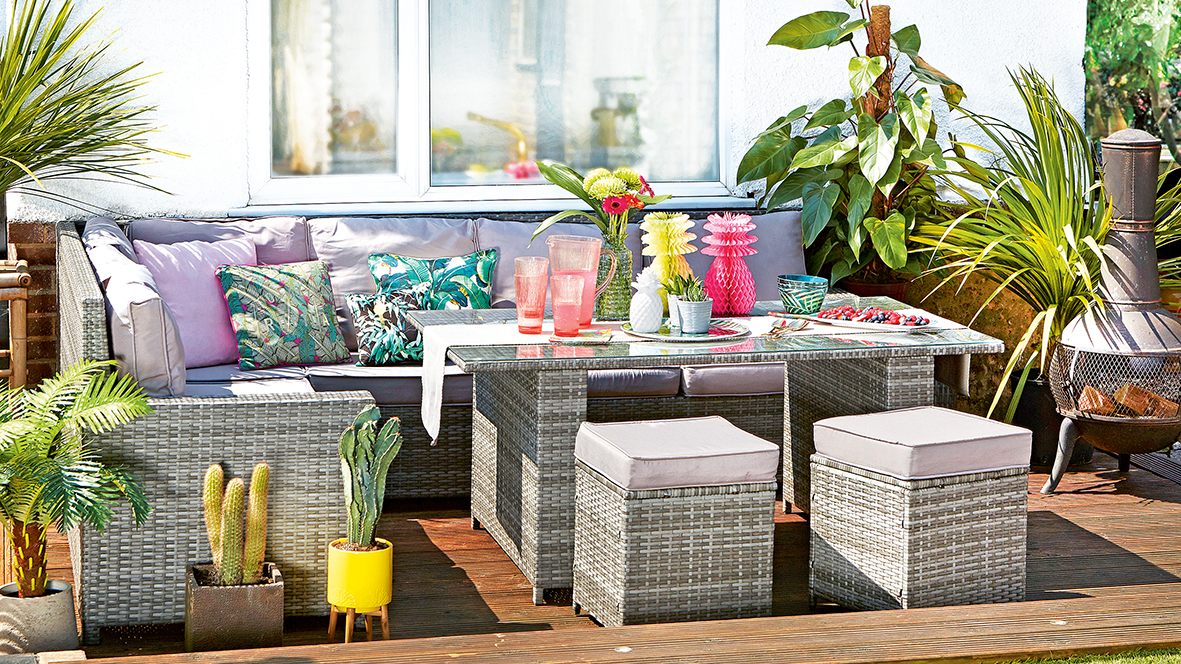
Well-chosen accessories can make a stylish statement
Create an enclosed seating area with plants all around you to give your space an exotic feel.
Throw in plenty of bright accessories to add vibrant pops of color, then make some fresh summer cocktails and bingo! You're living the tropical dream in your very own garden.
What plants go in a tropical garden?
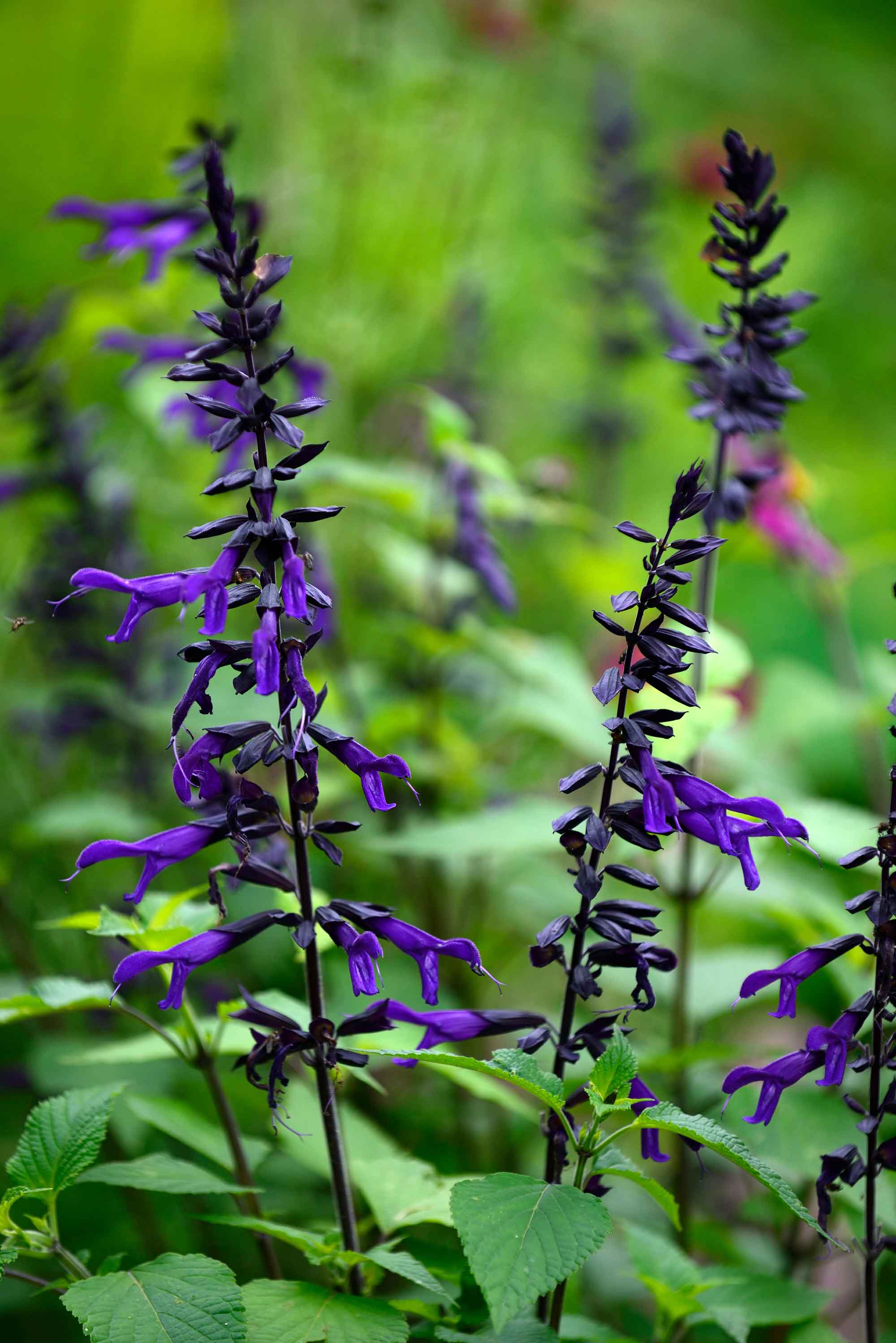
The vivid purple salvia 'Amistad' is an easy-care choice for exotic color
If you live somewhere that's more cold and drizzly than hot and humid, don't despair. ‘There are lots of sub-tropical plants that will give you that kind of look,' says garden expert, television presenter and writer Carol Klein. 'A few of them are hardy, and the great thing about them is they grow fast.’
Her recommended plants for tropical garden ideas include a variegated miscanthus grass: a hardy specimen with attractive green and white stripes. Carol also suggests using larger varieties of salvias, such as salvia 'Amistad' with its big, purple flowers – ideal for an immediately tropical feel. She also recommends the 'Carmencita' castor bean, however bear in mind that it's an annual – so will only flourish for one season.
If you're looking for more ideas, our best tropical plants guide has lots more lovely picks.
What colors should you use in tropical gardens?
Playing with garden color schemes is tons of fun when planning out tropical-inspired plots. Naturally, tones of deep green will be a go-to to evoke a jungle feel. Plenty of foliage can provide this, but don't be afraid to extend the theme to walls, textiles, or garden structures, too.
In the wild, these rainforest environments are also full of exotic birds and insects and beautiful florals which punctuate all that lush green growth. For a fun and vibrant feel, mirror nature by using hues of bright orange, eye-catching fuchsia, and cobalt and turquoise blues for accent pieces. Think a statement chair, an outdoor rug, or a patterned cushion, for example.
If you'd like to keep your space a little more pared-back, then neutrals can still work in tropical plots as long as there's plenty of plants. Cool black shades can provide a sophisticated backdrop to architectural leaves. And, they'll feel extra enticing when illuminated by gentle lighting after dark. Natural wooden decking can also provide a more rustic and organic feel, as can stone paving.

Geraldine is a gardener and garden writer, who has worked for over 12 years in historic public gardens and private gardens around London. She has written articles for Easy Gardens, Which? Gardening and Women’s Weekly Gardening Special magazines and for gardeningetc.com. She also edited the book ‘Britain’s Favourite Plants’ for the RHS.

